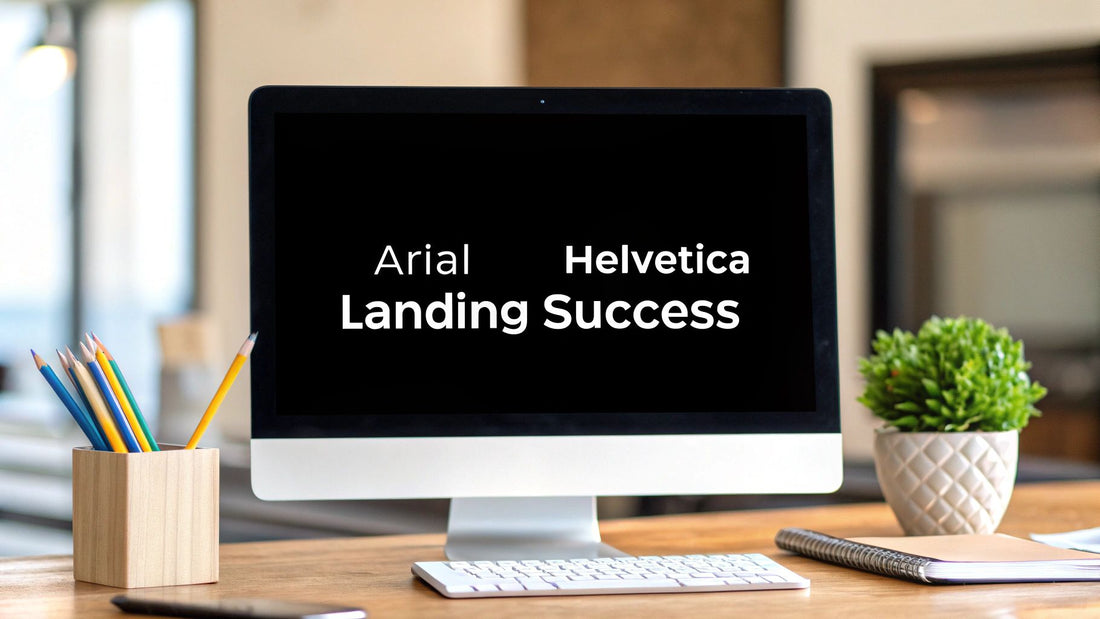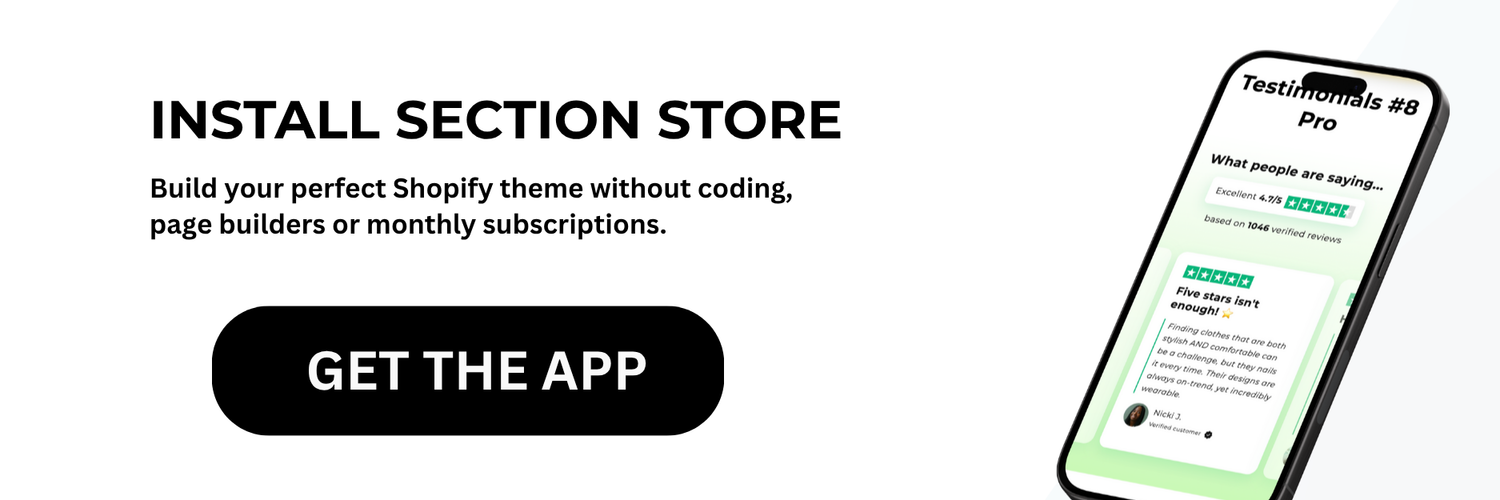Landing Pages That Convert
For Shopify merchants, landing pages are crucial for online store success. They transform clicks into customers. But simply having a landing page isn't enough. A poorly designed one can lose potential revenue quickly. Understanding best practices for landing page design is essential.
Landing page evolution mirrors online marketing's evolution. Early websites were often cluttered and confusing. As digital marketing matured, dedicated landing pages focused on a single conversion goal emerged. This shift stemmed from understanding user psychology and a streamlined user experience. Effective landing pages have clarity, compelling copy, a clear call to action, and a design that guides visitors toward conversion.
This guide explores 10 proven best practices for crafting high-converting landing pages for Shopify. You'll learn how to optimize your landing pages, turning them into powerful sales engines.
Value Proposition-Centered Design
For Shopify store owners, attracting visitors and turning them into paying customers is essential. Value Proposition-Centered Design is a key best practice. It addresses the core question every visitor has: "What's in it for me?" This design strategy prioritizes showcasing your unique value proposition (UVP) immediately—what's often called "above the fold"—so visitors see it without scrolling.

A strong UVP clearly communicates the benefits of what you offer. It addresses visitor pain points and explains why your store is the best choice compared to the competition. This is especially important on Shopify, where many stores compete for the same customers.
Features of a Value Proposition-Centered Design
- Clear, Concise Headline: Communicates the primary benefit simply and compellingly.
- Supporting Subheadline: Provides more context and details about the value proposition.
- Above-the-Fold Placement: Ensures the UVP is immediately visible at the top of the page.
- Alignment with Visitor Expectations & Search Intent: Addresses what the visitor expects based on their search or the ad that led them to your store.
Pros of a Strong UVP
- Answers "What's in it for me?": Immediately tells visitors why they should care about your products.
- Reduces Bounce Rates: Keeps visitors engaged by confirming the page's relevance.
- Sets Expectations: Establishes context for the rest of the page content.
- Qualifies Leads: Attracts customers genuinely interested in your offerings.
Cons of Implementing a UVP
- Crafting Effective UVPs is Challenging: Requires careful thought to create a resonant UVP.
- Requires Testing and Optimization: A/B testing is crucial to determine what works best.
- Simplifying Complex Offerings: Distilling complex products into a concise UVP can be difficult.
Examples of Effective UVPs
- Slack: "Where work happens. Slack is a collaboration hub for work, no matter what work you do." Slack
- Trello: "Trello helps teams move work forward. Collaborate, manage projects, and reach new productivity peaks." Trello
- Airbnb: "Belong anywhere. Unforgettable trips start with Airbnb." Airbnb
These examples highlight the power of clear, benefit-focused messaging.
Tips for Implementing UVPs on Shopify
- Focus on Benefits, Not Features: Highlight how features improve the customer's life.
- Use Simple Language: Avoid jargon your audience might not understand.
- Align UVP with Targeting: Tailor your UVP to the specific audience of each campaign.
- A/B Test Different Value Propositions: Experiment to find what resonates best with your audience.
Influential Figures in UVP Design
Marketing experts like Peep Laja of CXL and Oli Gardner of Unbounce have championed Value Proposition-Centered Design. Their work, along with resources like HubSpot marketing templates, emphasizes the importance of a strong UVP in converting visitors.
By implementing Value Proposition-Centered Design, Shopify store owners can significantly improve landing page effectiveness, boost conversion rates, and drive sales.
Single Conversion Goal Focus
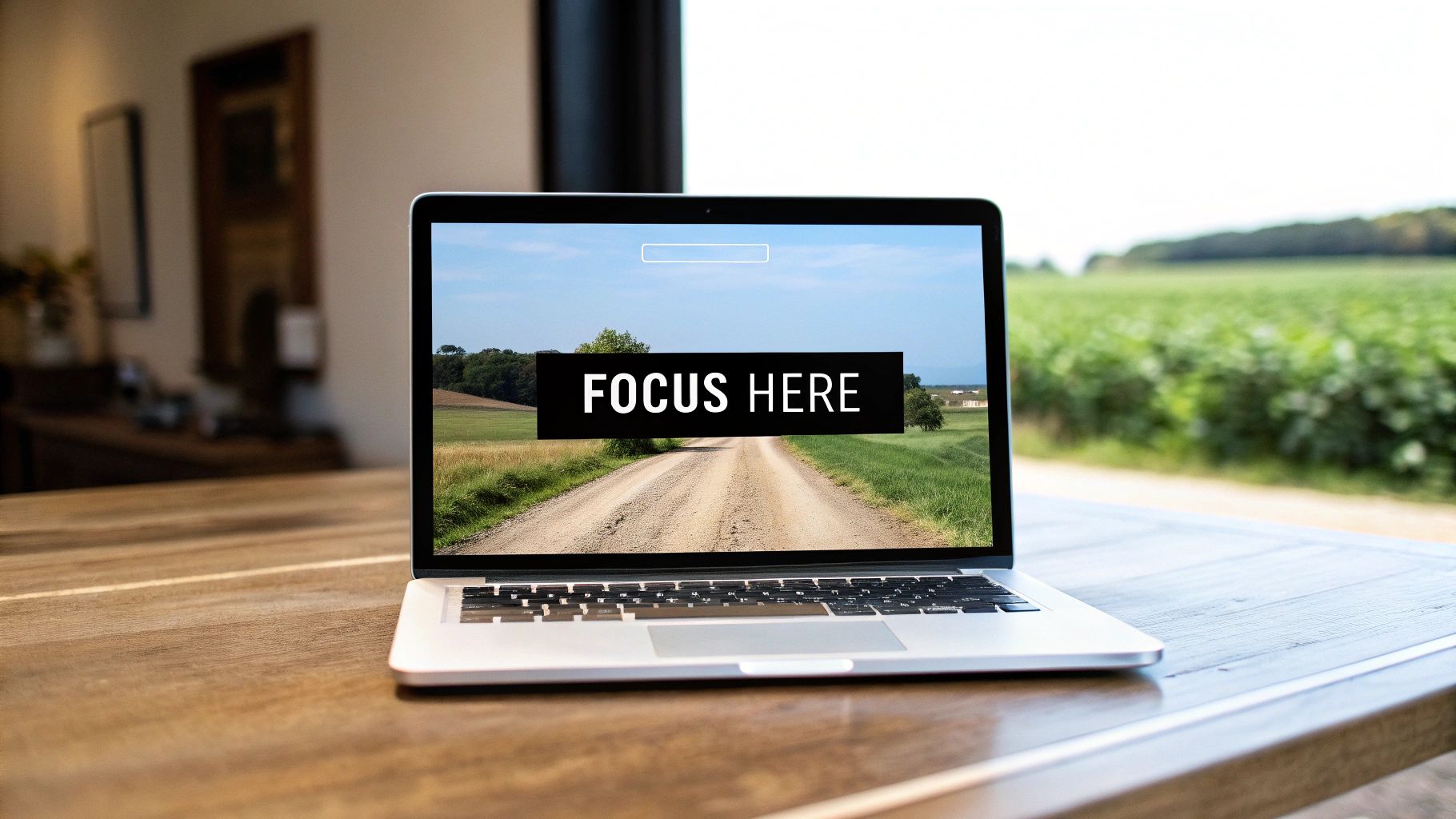
This best practice emphasizes creating Shopify landing pages with a laser focus on one clear call to action (CTA). Every element, from headlines and images to the body text, should guide visitors toward completing that specific action. Think of it as a direct path, leading straight to your desired result. This is crucial because it significantly improves conversion rates by minimizing distractions and creating a simple user experience.
Why is this so important for Shopify merchants? Imagine a visitor landing on your page from a targeted ad promoting a special discount. A single conversion goal ensures they can easily claim that discount, without getting lost or distracted by other offers.
Key Features of a Single Conversion Goal Focused Landing Page
- One Primary CTA Button/Form: This prominent element clearly states the action you want visitors to take (e.g., "Shop Now," "Get My Discount").
- Removal of Navigation Menus and External Links: Keep visitors focused by removing elements that might lead them away from the page.
- Focused Content: All text and visuals should reinforce the value proposition and encourage the desired action.
- Visual Hierarchy: Use design elements like whitespace and color contrast to draw attention to the CTA.
- Consistent CTA Placement: On longer pages, repeat the CTA at intervals to keep it readily available.
Pros of a Single Conversion Goal Focus
- Reduced Decision Fatigue: Presenting one clear option simplifies the decision-making process.
- Improved Conversion Rates: Fewer distractions lead to a higher likelihood of conversions.
- Simplified Analytics: Tracking performance and identifying areas for improvement becomes easier.
- More Effective A/B Testing: A clear focus helps determine the impact of changes to your landing page.
Cons of a Single Conversion Goal Focus
- Limited for Varied Visitors: It may not suit visitors at different stages of the buying process.
- Missed Opportunities: A hyper-focused approach might miss visitors looking for something else.
- Restrictive for Returning Visitors: The lack of navigation could frustrate returning visitors seeking more information.
Real-World Examples of Single Conversion Goal Focus
- Shopify Free Trials: These pages typically feature a single sign-up form with minimal distractions.
- Webinar Registrations: Companies like Zoom use dedicated landing pages for webinar registration, with a prominent registration form.
- Dropbox Landing Pages: These often focus on a single download or sign-up action.
Tips For Implementing a Single Conversion Goal Focus
- Distinctive CTA: Make the CTA stand out with contrasting colors and compelling copy.
- Remove Distractions: Eliminate navigation menus and footer links.
- Consistent CTA Buttons: Ensure all buttons drive the same conversion goal.
- Directional Cues: Consider using visual cues to guide attention to the CTA.
Evolution and Popularization
The single conversion goal focus was popularized by platforms like Unbounce and experts like Tim Ash, author of Landing Page Optimization. Instapage's conversion-focused templates also contributed to this approach. It evolved alongside A/B testing, emphasizing data-driven optimization for maximum conversion rates, especially crucial for Shopify stores focused on sales and lead generation.
Message Match Optimization
Message Match Optimization is key to getting the most out of your Shopify store's marketing. It simply means making sure your ads and landing pages are on the same page. Imagine clicking an ad for a specific blue widget, only to land on a generic homepage with no blue widgets in sight. Frustrating, right? Message match prevents this, smoothly guiding customers from click to conversion.
This strategy relies on creating a consistent experience between the first point of contact (your ad or referring link) and the landing page. This means using similar language, visuals, and offers to tell a cohesive story. When visitors find exactly what they expect, they’re much more likely to convert.
Features of Effective Message Match
- Consistent Headlines: Your landing page headline should reflect the promise made in your ad. If your ad promotes a "Summer Sale on Sandals," your landing page headline should too.
- Visual Continuity: Keep branding elements, colors, and imagery consistent. If your ad features a specific product image, use it on your landing page as well.
- Matching Offer Details: Make sure all offer details, like discount codes, free shipping thresholds, and promotional periods, are the same on both the ad and the landing page.
- Fulfillment of Expectations: If a referral source promises something specific, like a free ebook, your landing page should deliver immediately.
Why Message Match Matters for Your Shopify Store
- Reduces Confusion: Consistent messaging eliminates confusion and helps visitors quickly grasp the value proposition.
- Increases Quality Score (in Google Ads): Google rewards good message match with a higher Quality Score, potentially lowering your ad costs and improving ad position.
- Improves Conversion Rates: When expectations are met, visitors are more likely to complete the desired action, whether it's a purchase, newsletter signup, or quote request.
- Creates a Cohesive Customer Journey: A seamless transition from ad to landing page builds trust and a positive brand experience.
Pros & Cons of Message Match
| Pros | Cons |
|---|---|
| Higher conversion rates | Requires multiple landing pages |
| Improved Quality Score (Google Ads) | Can be resource-intensive for large campaigns |
| Reduced bounce rate | Might limit creative landing page design freedom |
| Enhanced user experience |
Real-World Examples
- Salesforce: Creates dedicated landing pages for each advertised product feature.
- HubSpot: Matches ad copy with landing page headlines for their marketing tools.
- Airbnb: Uses destination-specific visuals and copy in both ads and landing pages.
Practical Tips for Shopify Merchants
- Dedicated Landing Pages: Create unique landing pages for each ad campaign or major traffic source. Avoid sending all traffic to your homepage.
- Dynamic Text Replacement: Use dynamic text replacement (available through many ad platforms and landing page builders) to automatically match ad keywords to landing page copy.
- Highlight Offers: If your ad mentions an offer (e.g., "20% off"), make it prominent on the landing page.
- Visual Consistency: Maintain consistent color schemes, image styles, and button designs across ads and landing pages.
Evolution and Popularity
Message match optimization became important with the growth of pay-per-click (PPC) advertising and the increasing focus on user experience. Platforms like Google Ads encourage it, and many case studies have shown its positive impact on conversion rates.
Message Match Optimization is a must-have for any successful Shopify marketing campaign. Aligning your messaging creates a seamless and persuasive customer journey, leading to more conversions and a healthier bottom line.
Above-the-Fold Optimization: Making That First Impression Count
Above-the-fold optimization is essential for grabbing a visitor's attention quickly. It's all about maximizing the impact of the first impression—the content a visitor sees before scrolling down. This is especially critical for Shopify merchants facing fierce competition. You need to communicate your value proposition and entice visitors to explore further. With shrinking user attention spans, engaging visitors immediately is more important than ever for increasing conversions.
What exactly does above-the-fold optimization entail? It involves strategically placing the most important elements within that initial viewport. Think of it as your digital storefront window displaying your best products and offers:
-
Strategic Headline and Subheadline: Communicate your core value proposition clearly and concisely—what problem do you solve?
-
Compelling Call to Action (CTA): Make it obvious what action you want visitors to take ("Shop Now," "Learn More," etc.). The CTA should be prominent and visually distinct.
-
Impactful Visuals: High-quality images or videos that load quickly and reinforce your message are key. Avoid cluttered visuals.
-
Concise Value Proposition: Briefly explain the key benefits of your product or service—why should someone choose you?
Real-World Examples of Effective Above-the-Fold Design
-
Stripe: Stripe's homepage demonstrates above-the-fold optimization with a clear headline, concise subheadline, and a simple visual.
-
Netflix: Netflix’s signup page uses minimal copy, a prominent free trial button, and a captivating background image.
-
Evernote: Evernote's clean design highlights key features and provides an immediate download option.
Why Above-the-Fold Optimization Matters for Shopify Merchants
In the competitive eCommerce landscape, grabbing attention quickly is paramount. Shopify merchants often use targeted advertising campaigns that drive traffic to specific landing pages. Optimizing the above-the-fold area of these pages can significantly impact conversion rates.
Here’s a quick look at the pros and cons:
| Pros | Cons |
|---|---|
| Catches Short Attention Spans | Limited Space |
| Reduces Bounce Rates | Design Challenges Across Different Screens |
| Mobile-Friendly | Potential Oversimplification |
| Increases Chances of Faster Conversions |
Tips for Implementing Above-the-Fold Optimization
-
Heatmaps: Use heatmap tools to analyze how users interact with your above-the-fold content.
-
Mobile-First: Ensure critical information is visible without scrolling on all devices.
-
Visual Cues: Use subtle visual cues (arrows, partially visible images) to indicate more content below the fold.
-
A/B Testing: Experiment with different arrangements of elements to optimize for conversions.
The History of Above-the-Fold
The concept originates from the print newspaper industry, where important stories were placed "above the fold" for immediate visibility. This principle was adapted to the digital realm and popularized by usability research from the Nielsen Norman Group and Jakob Nielsen's studies on F-pattern reading behavior. More recently, Google's Page Experience metrics have further emphasized its importance.
By prioritizing above-the-fold optimization, Shopify merchants can significantly improve landing page performance and drive more conversions. Make that first impression count!
Social Proof: Building Trust on Your Shopify Landing Page
Social proof is a powerful tool for online businesses. It leverages the human tendency to follow the actions of others. Seeing that other people trust your brand encourages new visitors to trust you, too. This is particularly important on a Shopify landing page, where you need to quickly build credibility and encourage sales. Why is social proof so important? It directly addresses the challenge of building trust with an audience you haven't met face-to-face.
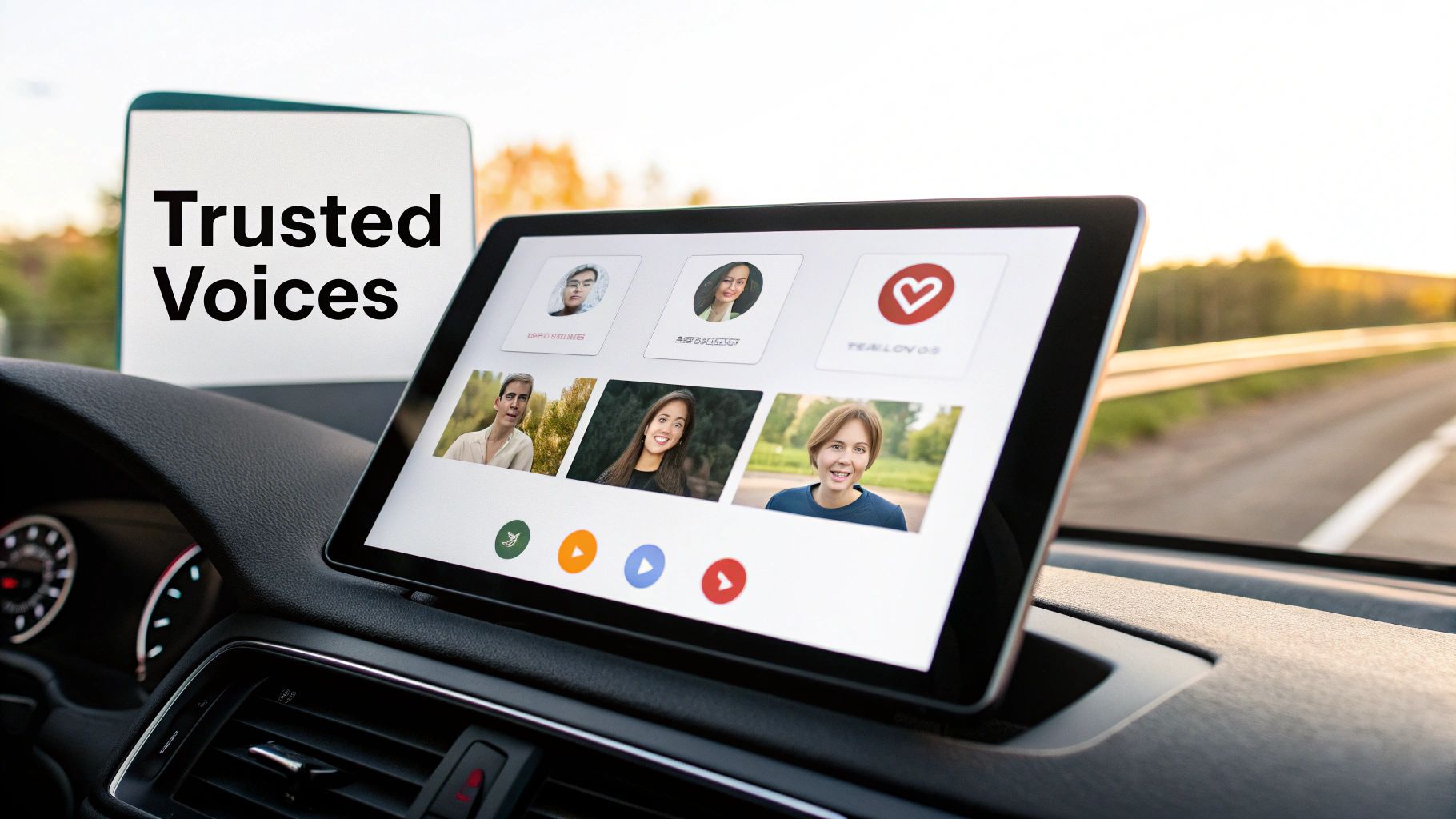
Features of Effective Social Proof
Here are some key features of effective social proof integration:
- Customer Testimonials: Feature testimonials that highlight specific results. Include photos and full names to add authenticity. Avoid generic praise.
- Security Badges: Display recognizable security badges, such as Norton Secured or McAfee Secure, to reassure visitors about their information security.
- Customer Logos: Showcasing logos of well-known companies that use your product or service can elevate your brand's image.
- Statistics: Use quantifiable data, like "Used by 10,000+ Shopify stores," to demonstrate your reach and popularity.
- Review Integrations: Embed reviews from platforms like Trustpilot or Yotpo directly onto your landing page for real-time social validation.
Pros of Using Social Proof
- Credibility: Testimonials and social proof build immediate credibility and reduce perceived risk.
- Reduced Skepticism: Real-world examples of positive experiences overcome doubts and objections.
- Vision of Success: Testimonials with specific results help potential customers envision themselves achieving similar benefits.
- High-Value Purchases: Social proof is especially effective for high-consideration or high-cost products.
Cons of Using Social Proof
- Clutter: Too much social proof can overwhelm visitors.
- Fake Testimonials: Authenticity is key; avoid generic or fake-looking testimonials.
- Ongoing Effort: Building a library of social proof requires ongoing collection and curation of customer feedback.
Real-World Examples of Social Proof
Here are a few examples of companies effectively using social proof:
- Zoom: Features logos of major corporations on their landing page.
- Basecamp: Displays metrics like "3,939 companies signed up last week."
- Codecademy: Integrates success stories with specific career outcomes.
Tips for Shopify Landing Page Optimization
Here are a few tips to effectively use social proof on your Shopify store:
- Industry-Specific Testimonials: Tailor your social proof to resonate with your target audience.
- Specific Metrics: Use concrete numbers and results in your testimonials.
- Strategic Placement: Place social proof near points of friction or decision-making in the customer journey.
- A/B Testing: Rotate testimonials to see which ones perform best.
- Photos and Names: Include photos and full names whenever possible.
The Growing Importance of Social Proof
The concept of social proof was popularized by Robert Cialdini's book, Influence: The Psychology of Persuasion. His work highlighted the human tendency to follow others. Organizations like ConversionXL have also confirmed the impact of social proof on online conversions. The rise of testimonial platforms like Trustpilot and Yotpo shows how accessible social proof has become. For Shopify store owners, integrating social proof is essential for building trust and increasing sales.
Frictionless Form Design For Shopify
Converting visitors into paying customers is the ultimate goal for any Shopify merchant. Forms, whether for lead capture, account creation, or purchases, play a crucial role in this process. Frictionless form design is all about optimizing these forms to make them incredibly easy for visitors to complete. This directly impacts your bottom line by boosting conversion rates and growing your customer base.
Frictionless form design involves carefully considering every aspect of your forms, from the number of fields to the overall user experience. The core idea is simple: make form completion as painless and intuitive as possible while still collecting the necessary information.
Key Features of Frictionless Forms
- Minimal Number of Fields: Ask only for essential information. Each extra field increases the chance of abandonment.
- Smart Field Ordering: Start with the easiest information (like name) and gradually progress to more complex details (like address).
- Progressive Form Disclosure: For longer forms, reveal sections step-by-step to avoid overwhelming users.
- Clear Error Handling and Inline Validation: Provide instant feedback if a field is filled out incorrectly, guiding users toward a quick correction.
- Autofill Compatibility and Smart Defaults: Take advantage of browser autofill and pre-fill fields with sensible defaults to minimize typing.
Benefits of Frictionless Forms
- Higher Completion Rates: Fewer fields and a smoother experience lead to more submissions.
- Reduced Abandonment: Users are less likely to give up when the process is simple.
- Positive Brand Perception: A streamlined experience reflects professionalism and respect for the user’s time.
- Mobile-Friendly Interaction: Crucial for mobile users, where typing can be cumbersome.
Potential Drawbacks
- Potential for Lower Lead Quality: Asking for less information might mean missing out on valuable data. Finding the right balance is key.
- Balancing Conversion and Information Gathering: This requires careful planning and testing to determine essential information.
- Potential for More Backend Processing: Collecting less initial information might require more follow-up or data enrichment later.
Examples in Action
- HubSpot's progressive profiling: Gradually gathers more information on return visits.
- Typeform's conversational forms: Transforms form completion into a natural dialogue.
- Amazon's one-click purchase: The classic example of minimizing friction during checkout.
Practical Tips for Shopify Merchants
- Use multi-step forms: Break down long forms into smaller, digestible chunks. Shopify apps can help with this.
- Review Optional Fields: Remove or clearly mark optional fields to reduce clutter.
- Implement Real-Time Validation: Catch errors instantly and provide immediate feedback.
- Use Appropriate Input Types: Use date pickers, dropdowns, etc., to minimize typing.
- Test Form Placement: A/B testing can help determine the optimal placement for your audience.
Origins and Growth
Frictionless form design has gained traction thanks to usability experts like Luke Wroblewski (author of "Web Form Design") and research institutions like The Baymard Institute. Platforms like FormStack have also played a role in promoting these best practices.
By implementing these strategies, Shopify merchants can significantly improve conversion rates, create a more positive user experience, and drive business growth. Frictionless form design is about streamlining the process for a better customer experience.
Video Integration Strategy
Video has become incredibly popular online, and using it on your Shopify landing page can make it much more effective. A well-placed video can explain your product's value, connect with your audience, and ultimately boost sales. This is a best practice because it works for different learning styles and can dramatically increase engagement.
A video integration strategy means adding different kinds of videos to your landing page. This could include:
-
Explainer Videos: These videos quickly explain your product's benefits and how it solves a customer's problem. Think of Dropbox's early explainer video—simple animation, clear message, and a big reason for their growth.
-
Product Demonstrations: Show your product in action, highlighting key features. Wistia, a video hosting platform, does this well, using their own product to show what it can do.
-
Customer Testimonial Videos: Real customer stories build trust. Airbnb uses this effectively, sharing stories of hosts and guests to create a positive feeling about their service.
-
Background Videos: These add visual interest without requiring direct interaction.
-
Strategically Placed Content: Videos should be placed carefully with attractive thumbnails to encourage clicks.
Why Video Works
Video helps you explain complicated ideas better than text alone, which is great for visual learners. It also creates a more interesting experience, leading to more time spent on your landing page. Telling stories with video can create an emotional connection with your audience, making your brand and product more memorable.
The Rise of Video on Landing Pages
Platforms like Wistia promoted video marketing on landing pages, providing data and tools to show its impact. Unbounce, a landing page platform, also helped make this strategy popular with their video landing page templates. The success of Dollar Shave Club's video marketing showed how powerful video can be for brand awareness and sales.
Pros
- Increased time spent on the page and better engagement.
- Explains complicated ideas effectively.
- Creates emotional connections through stories.
- Works well for visual learners.
Cons
- Can slow down page loading if not optimized.
- Requires resources to create and update.
- Not everyone will watch videos (provide text alternatives).
- May not work in every situation.
Tips for Shopify Landing Page Videos
- Keep it Concise: Aim for 30-90 seconds. Get to the point quickly.
- Compelling Thumbnails: Use high-quality, attention-grabbing thumbnails that accurately show what the video is about.
- Captions are Key: Add captions for accessibility and for people watching without sound.
- No Autoplay with Sound: This can be annoying.
- Don't Rely Solely on Video: Make sure important information is also in text form.
- Clear Call to Action (CTA): Include a CTA in or right after the video to tell viewers what to do next.
By following these tips and using video strategically on your Shopify landing pages, you can create more engaging experiences, build stronger relationships with your audience, and ultimately increase sales.
Mobile-First Optimization
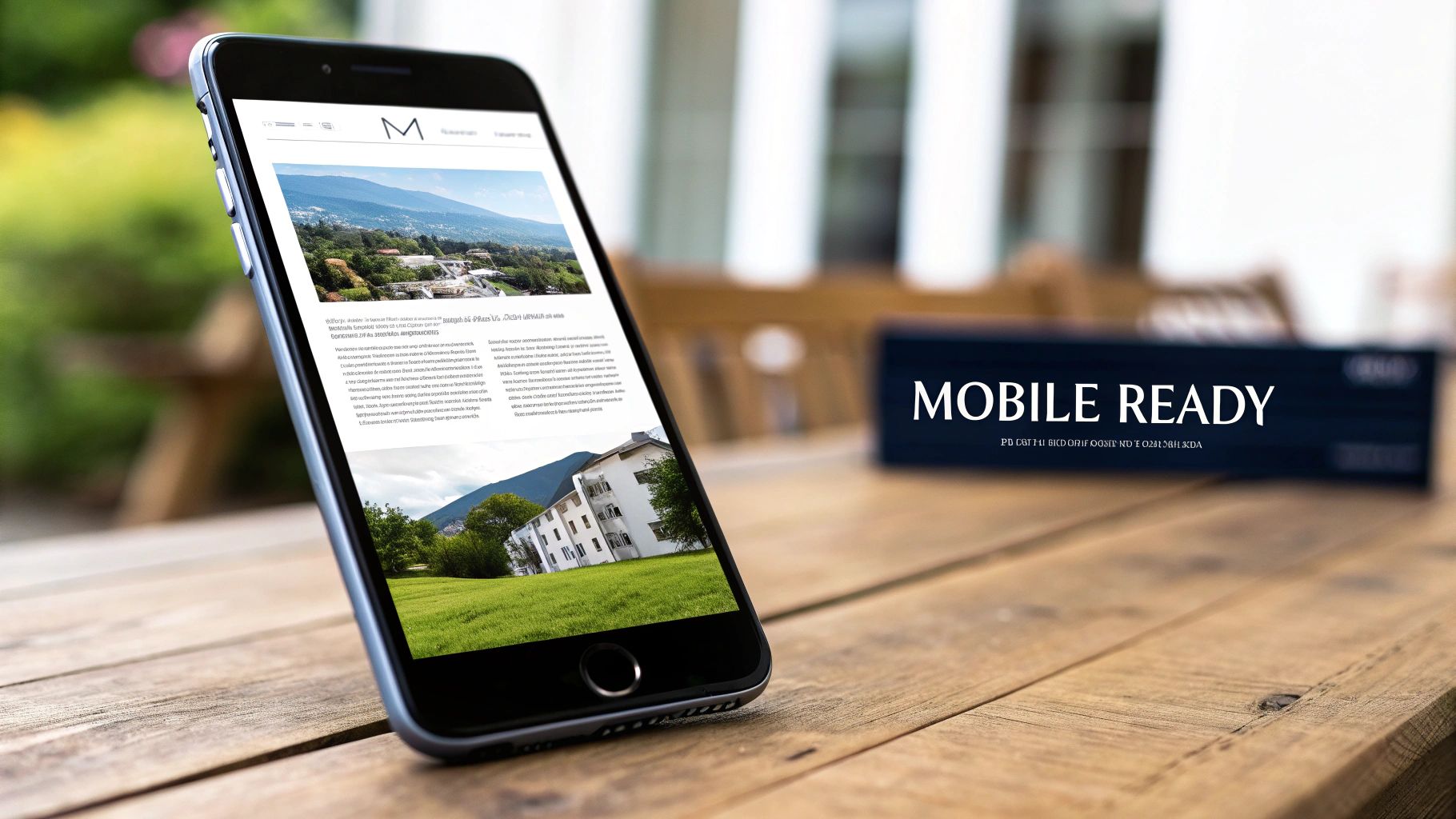
For Shopify merchants, a seamless mobile experience is essential. Mobile-first optimization prioritizes the mobile user experience. It designs for smaller screens first and then scales up for larger devices like desktops. With most online shopping happening on smartphones, this approach is crucial for maximizing conversions.
It's also a critical best practice for landing pages.
Why Mobile-First Matters For Shopify Stores
Imagine a potential customer finds your product through a social media ad on their phone. If your landing page isn't mobile-friendly, they'll likely leave. Slow loading times, difficult navigation, or tiny buttons can cause this. A mobile-first design ensures positive first impressions, leading to better engagement and more sales.
Key Features of a Mobile-First Landing Page
-
Touch-Friendly Interface: Use large, easily tappable buttons and input fields. Avoid small dropdown menus and complicated forms.
-
Vertical Scrolling Layout: Embrace vertical scrolling. Long, vertically oriented content works well on mobile.
-
Optimized Performance: Compress images and minimize code for fast loading speeds. This is important even on slower connections.
-
Simplified Navigation: Streamline your menus for easy navigation. Users should find what they need quickly.
-
Thumb-Friendly Interaction Zones: Place key elements like calls-to-action within thumb reach. This is usually at the bottom center or lower right of the screen.
-
Responsive Design: While prioritizing mobile, ensure your landing page adapts to any screen size. This provides a consistent experience across devices.
Pros of Mobile-First Design
-
Caters to the Mobile Majority: Focuses on the growing number of mobile shoppers. This optimizes for how most customers interact with your store.
-
Boosts SEO: Google prioritizes mobile-friendly websites in search results. This gives you an advantage.
-
Content Prioritization: Limited screen space encourages a focus on essential content, resulting in clearer messaging.
-
Consistent Experience: Creates a user-friendly experience across all devices.
Cons of Mobile-First Design
-
Potential Feature Limitations: Complex forms or interactive elements can be challenging on mobile.
-
Rigorous Testing Required: Thorough testing is essential across various devices and operating systems.
Real-World Examples of Mobile-First
-
Google: Google's landing pages exemplify this approach.
-
Uber: Their mobile signup flow is optimized for quick conversions.
-
Instagram: Their web presence reflects mobile interaction patterns.
Practical Tips for Shopify Merchants
-
Test Page Speed: Use tools like Google PageSpeed Insights to analyze and optimize your loading times.
-
Implement Large Tap Targets: Ensure buttons are at least 48px for easy tapping.
-
Use Single-Column Layouts: These adapt well to different screen sizes.
-
Consider Device Orientation: Design for both portrait and landscape modes.
-
Strategically Place CTAs: Position call-to-action buttons within thumb reach.
The Rise of Mobile-First
Mobile-first design gained traction with the rise of smartphones. Google's mobile-first indexing solidified its importance for SEO. Designers like Luke Wroblewski and Ethan Marcotte played key roles in its growth.
By implementing mobile-first optimization, you improve the user experience. You also boost conversion rates and stay competitive in the mobile-centric market.
A/B Testing Framework For Your Shopify Store
A/B testing is a powerful tool for continuously improving your Shopify store. It helps you optimize landing pages based on data, not guesswork. You create two or more versions of a page, changing only one element, then split your traffic between them. By tracking which version performs better, you can make informed decisions about your landing page design.
This framework is essential because it makes landing page optimization a scientific process. Instead of relying on opinions, you let your customers show you what truly works.
How A/B Testing Works
- Identify a Problem Area: Perhaps your headline isn't engaging, or your call-to-action (CTA) button is being ignored.
- Create Variations: Design a "B" version of your page, modifying only the chosen element. For example, try a different CTA button color or rewrite your headline.
- Split Traffic: Direct some visitors to the original ("A") version and the rest to the modified ("B") version.
- Measure Results: Track key metrics like conversion rate, bounce rate, and time on page for each version.
- Analyze and Iterate: See which version performs better statistically. Implement the winner and repeat the process with another element.
Building an Effective A/B Testing Framework
- Data-Driven Decisions: Make choices based on user behavior, not intuition.
- Controlled Testing: Change only one variable at a time to isolate its effect.
- Statistical Significance: Ensure results are reliable and not random.
- Iterative Process: Continuously test and refine for constant improvement.
- Multivariate Testing: For more advanced testing, experiment with multiple variations at once.
Pros of A/B Testing
- Concrete Evidence: Understand what your audience responds to based on real data.
- Reduced Risk: Avoid costly redesigns by testing incrementally.
- Increased Conversions: Small improvements accumulate into significant gains.
- Culture of Optimization: Foster a data-driven approach to decision-making.
Cons of A/B Testing
- Traffic Requirement: You need enough traffic for statistically significant results. Low traffic means longer testing times.
- Time Investment: Setup and analysis require time and attention.
- Potential for Error: Incorrect setup can lead to inaccurate conclusions.
- Tooling/Expertise: You might need specialized A/B testing tools or expert knowledge. VWO (Visual Website Optimizer) is another popular platform.
Real-World A/B Testing Examples
- Booking.com: Known for running thousands of A/B tests concurrently to constantly optimize conversions.
- HubSpot: Documented a 24% conversion increase by A/B testing their CTA button copy.
- Moz: Improved landing page conversion rates by 52% through systematic testing.
A/B Testing Tips for Shopify Merchants
- Start with High-Impact Elements: Focus on headlines, CTAs, and form fields first. Try different product images, adding testimonials, or changing the "Add to Cart" button placement.
- Ensure Statistical Significance: Use a calculator or A/B testing tool to validate your results.
- Test One Element at a Time: Isolate the impact of each change.
- Document Everything: Keep records of your hypotheses, variations, and results.
- Segment Results: Analyze results by traffic source (e.g., Facebook Ads, organic search) or device type for better insights.
By implementing a solid A/B testing framework, you can maximize your Shopify store's potential and significantly improve your bottom line.
Benefit-Focused Content: Speak Directly To Your Customer
Stop selling features, start selling benefits. This core principle drives benefit-focused content hierarchy. Instead of technical jargon, prioritize what your product does for the customer. Answer the key question: "What's in it for me?" This approach resonates with how people buy, making it a best practice for effective landing pages.
Why is this so important? For Shopify merchants in a competitive marketplace, highlighting the positive impact of your products differentiates you and persuades customers.
How Benefit-Focused Content Works
Benefit-focused content hierarchy arranges information based on customer value. Lead with outcome-focused headlines that immediately communicate your product's transformation. Consider a problem-agitation-solution structure. Acknowledge the pain point, amplify it, and present your product as the solution. Then, pair benefit statements with supporting features. For example, instead of "Our shoes use advanced cushioning," try "Experience all-day comfort with our advanced cushioning technology." Finally, strategically organize content, presenting the most compelling benefits first to capture attention.
Features of Benefit-Focused Content
- Outcome-Focused Headlines: Instead of "New Lightweight Design," try "Run Further, Feel Lighter."
- Transformation-Oriented Messaging: Showcase the "before" and "after" story.
- Problem-Agitation-Solution Narrative: Address the pain point, emphasize it, then present your product as the relief.
- Benefit Statements + Supporting Features: Explain how features deliver benefits.
- Strategic Content Chunking: Prioritize impactful benefits for those who skim.
Pros of Benefit-Focused Content
- Directly addresses the "How does this help me?" question.
- Creates emotional connection before logic.
- Caters to both skimmers and in-depth readers.
- Aligns with buying psychology.
Cons of Benefit-Focused Content
- Requires understanding your audience's motivations.
- Demands strong copywriting.
- Identifying the most compelling benefits can be challenging.
Real-World Examples of Benefit-Focused Content
- Apple: Product pages often showcase lifestyle images and benefit-driven language.
- Mailchimp: Focuses on helping businesses grow their audience, not just email features.
- Fitbit: Emphasizes health improvements, not just tracking capabilities.
Tips for Shopify Merchants
- Voice-of-Customer Research: Use surveys and reviews to understand customer needs.
- Benefit → Explanation → Feature: Connect benefits to features clearly.
- Quantifiable Outcomes: Use data. For example, "Increase conversions by 15%."
- Visual Hierarchy: Use headings and bold text to emphasize benefits.
- Targeted Messaging: Tailor benefits to different customer segments.
Influences and Evolution
Benefit-focused content is rooted in consumer psychology. Copyhackers championed this approach. Donald Miller's StoryBrand framework encourages businesses to position customers as heroes. The problem-agitation-solution framework also plays a key role.
By focusing on benefits, you transform landing pages into conversion tools that resonate and drive sales.
Top 10 Landing Page Strategies: Side-by-Side Comparison
| Strategy | 🔄 Complexity | ⚡ Resources | 📊 Outcomes | ⭐ Advantages |
|---|---|---|---|---|
| Value Proposition-Centered Design | Medium – Requires refined copy and iterative testing | Moderate – Involves copywriting and optimization work | Immediate engagement; reduces bounce rates | Clearly communicates benefits and qualifies leads |
| Single Conversion Goal Focus | Low-Medium – Focused design tweaks and removal of distractions | Low – Simple layout adjustments | Higher conversion rates; streamlined user path | Simplifies decision making by eliminating clutter |
| Message Match Optimization | Medium-High – Needs alignment across channels and variants | High – Multiple landing page variants and dynamic elements | Increases conversion; improves ad Quality Scores | Creates a seamless experience by matching messaging |
| Above-the-Fold Optimization | Medium – Requires careful layout and testing across devices | Moderate – Involves design and A/B testing efforts | Captures attention immediately; boosts conversions | Engages users quickly by prioritizing critical elements |
| Social Proof Integration | Low-Medium – Adding testimonials and trust badges is straightforward | Low – Mainly gathering and displaying social cues | Builds trust and credibility; reduces perceived risk | Reinforces user confidence through real-world validation |
| Frictionless Form Design | Medium – Balancing minimal fields with effective data capture | Moderate – Involves UX design and backend adjustments | Higher form completions; reduced abandonment | Simplifies conversion process with optimized interactions |
| Video Integration Strategy | High – Involves production, editing, and integration | High – Requires production resources and hosting solutions | Increased engagement and clearer explanations | Creates emotional connections through dynamic storytelling |
| Mobile-First Optimization | Medium – Requires responsive design and rigorous testing | Moderate – Investment in mobile design and performance tools | Enhanced mobile performance; SEO benefits | Delivers a superior experience for growing mobile traffic |
| A/B Testing Framework | High – Setup demands systematic testing and analysis | High – Needs sufficient traffic and specialized tools | Data-driven improvements; significant conversion lift | Validates design changes with measurable evidence |
| Benefit-Focused Content Hierarchy | Medium – Demands customer insight and expert copywriting | Moderate – Involves strategic content planning and research | Improved engagement; clearer customer value communication | Emphasizes customer outcomes and creates an emotional connection |
Start Optimizing Your Landing Pages Now
Creating effective landing pages isn't a one-time project; it's an ongoing process. By focusing on core principles—a clear value proposition, a single conversion goal, mobile optimization, and A/B testing—you can significantly improve your conversion rates. Don't forget the importance of social proof, concise forms, and engaging videos to enhance the user experience and build trust with your audience. Understanding your target audience and tailoring your message to their specific needs and pain points is vital for success. Keep your content focused on the benefits you offer, ensuring visitors quickly understand the value you provide.
Putting these concepts into action means getting to know your target audience inside and out. Craft a message that speaks directly to their needs and addresses their pain points. This will resonate far more effectively than generic marketing copy.
Staying Ahead of the Curve
The online world is constantly changing. Stay ahead by monitoring emerging trends like personalized experiences, interactive content, and the growing importance of mobile-first design. Regularly analyze your landing page performance, adapt to user behavior, and refine your approach based on the data you gather. Remember, even small adjustments can have a noticeable impact on your results.
Key Takeaways
- Clarity is Paramount: A clear value proposition and a single conversion goal are essential for landing page success.
- User-Focused Design: Prioritize the user experience above all else; make it easy and enjoyable for visitors to achieve their goals on your page.
- Data-Driven Refinement: A/B testing and ongoing analysis are crucial for long-term success and continuous improvement.
Ready to build stunning, high-converting landing pages for your Shopify store without coding or expensive subscriptions? Section Store offers pre-made Shopify sections that seamlessly integrate with any theme. Add sections just like you would with your theme editor, for a low one-time fee per section. Start creating landing pages that deliver real results today! Get started with Section Store


